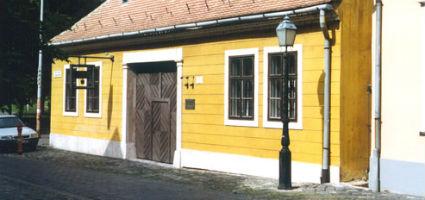2024. April 19. Friday
Budapest Gallery Varga Imre Permanent Exhibition - Budapest
 |
Address: 1033, Budapest Laktanya utca 7.
Phone number: (1) 250-0274
E-mail: galeria@mail.btm.hu
Opening hours: Tue-Sun 10-18
|
Imre Varga (Siófok, 1923) graduated at the Military Academy in aeronautics. In WWII, he served as an air officer. He returned to Hungary from captivity 1945. He met Pál Pátyai, sculpture, by accident after which he applied for the Collage of Fine Arts. He attended the first Hungarian Exhibition of Fine Arts with his statue titled 'Iron Worker' when he still attended collage.
He is an active artist in all fields of sculpturing. He has made small statues and coins besides designing and executing monumental compositions for public places such as memorials, portrait memorials, ornamental plastic works etc. He also did graphics, goblins, and panel pictures.
His first work of interest was titled 'Prometheus' presented in 1965. The statue, later moved to the Open Air Museum of Antwerp, was made of chrome steel. His first exhibition in 1967 aroused a considerable curiosity among the professionals. His exhibition in Tihany in 1972 put him among the core of contemporary artists. His dynamic statues made mainly with bronze casting and molding are usually erected on public places, in natural and designed environment. His technique of applying chrome steel acquired in the second half of the 60's is also significant. He often used different techniques on one piece. He sensitively mixed his classicist approach with elements of pop art to produce artworks fit in natural circumstances charged with sensitivity.
From the end of the 60's the most important characteristic of his art was anti-heroism, namely to put heroes into anthropocentric situations emphasizing the casual features of man. The central figure of his art is history and the significant figures of Hungarian culture and art like Ferenc Rákóczi II, Mihály Károlyi, Miklós Radnóti, Attila József, Ferenc Liszt, and Béla Bartók, but he also pictured figures of the Bible and the mythology.
Important field of his oeuvre is the monumental masonry. His strongest small statues are characterized by expressivity and surrealist vision.
He is an active artist in all fields of sculpturing. He has made small statues and coins besides designing and executing monumental compositions for public places such as memorials, portrait memorials, ornamental plastic works etc. He also did graphics, goblins, and panel pictures.
His first work of interest was titled 'Prometheus' presented in 1965. The statue, later moved to the Open Air Museum of Antwerp, was made of chrome steel. His first exhibition in 1967 aroused a considerable curiosity among the professionals. His exhibition in Tihany in 1972 put him among the core of contemporary artists. His dynamic statues made mainly with bronze casting and molding are usually erected on public places, in natural and designed environment. His technique of applying chrome steel acquired in the second half of the 60's is also significant. He often used different techniques on one piece. He sensitively mixed his classicist approach with elements of pop art to produce artworks fit in natural circumstances charged with sensitivity.
From the end of the 60's the most important characteristic of his art was anti-heroism, namely to put heroes into anthropocentric situations emphasizing the casual features of man. The central figure of his art is history and the significant figures of Hungarian culture and art like Ferenc Rákóczi II, Mihály Károlyi, Miklós Radnóti, Attila József, Ferenc Liszt, and Béla Bartók, but he also pictured figures of the Bible and the mythology.
Important field of his oeuvre is the monumental masonry. His strongest small statues are characterized by expressivity and surrealist vision.